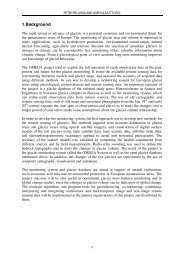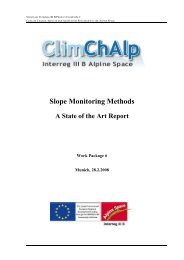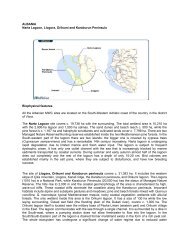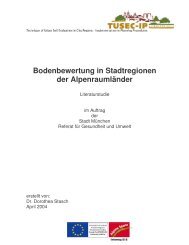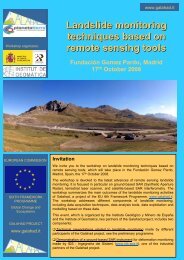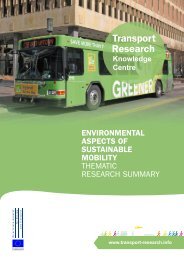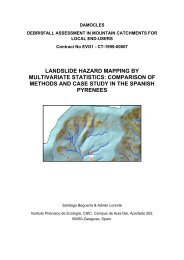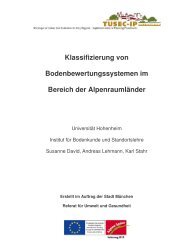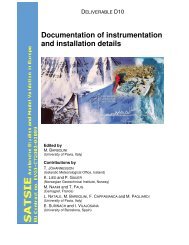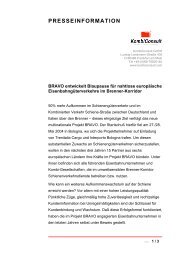Deliverable D3.1.2 Key products of the forest-based industries and ...
Deliverable D3.1.2 Key products of the forest-based industries and ...
Deliverable D3.1.2 Key products of the forest-based industries and ...
Create successful ePaper yourself
Turn your PDF publications into a flip-book with our unique Google optimized e-Paper software.
<strong>Key</strong> <strong>products</strong> <strong>of</strong> <strong>the</strong> <strong>forest</strong>-<strong>based</strong> <strong>industries</strong><strong>and</strong> <strong>the</strong>ir dem<strong>and</strong>s on wood raw material propertiesThe ambition has not been to list all possible <strong>products</strong> produced in all countries, but ra<strong>the</strong>r <strong>the</strong> key<strong>products</strong> or types <strong>of</strong> <strong>products</strong> <strong>of</strong> <strong>the</strong> different production chains. The ambition has been to defineproduct types covering at least 80 % <strong>of</strong> <strong>the</strong> production within Europe as a whole, so that <strong>the</strong> listedproduct types will cover at least 60-80 % <strong>of</strong> <strong>the</strong> production for <strong>the</strong> regions in which ToSIA, <strong>the</strong> Tool forSustainability Impact Assessment, is foreseen to be used within <strong>the</strong> EFORWOOD project <strong>and</strong>afterwards. Ano<strong>the</strong>r ambition has been to aggregate <strong>the</strong> types <strong>of</strong> <strong>products</strong> to a limited set which ispossible to relate to available statistics on consumption, production, import, export, etc.The selection <strong>of</strong> <strong>the</strong> key <strong>products</strong> has been performed in cooperation with experts engaged in relatedtasks within Modules 4 <strong>and</strong> 5. The starting point has been to identify <strong>the</strong> main types <strong>of</strong> converted<strong>products</strong> used by <strong>the</strong> end-user, such as books, sacks, outdoor furniture, pallets, floor systems, pellets,etc. <strong>and</strong> to follow <strong>the</strong> chains back to <strong>the</strong> raw material. For example a book (converted product in M5) isin most cases printed with <strong>of</strong>fset or digital printing on printing paper (paper product in M4), which inturn is manufactured from bleached kraft (chemical) pulp (pulp product in M4) produced fromhardwood <strong>and</strong>/or s<strong>of</strong>twood (raw material from M3) or from <strong>the</strong>rmo mechanical pulp (TMP) from sprucewood (M3) or from de-inked pulp (DIP) from paper collected in M5 <strong>and</strong> upgraded in M4.The lists <strong>of</strong> key <strong>products</strong> have also proven useful in <strong>the</strong> preparation <strong>of</strong> <strong>the</strong> regional cases. Theestablishment <strong>of</strong> <strong>the</strong> general layout <strong>of</strong> <strong>the</strong> fibre chains <strong>of</strong> <strong>the</strong> Iberian case study, which applies aconsumer perspective on <strong>the</strong> <strong>forest</strong>ry wood chain, may be used as an example. We started by lookinginto <strong>the</strong> statistics for paper consumption in Spain <strong>and</strong> Portugal. 4 product types which constitutedabout 70 % <strong>of</strong> <strong>the</strong> consumption <strong>of</strong> paper were identified. We <strong>the</strong>n concluded that most <strong>of</strong> <strong>the</strong>se<strong>products</strong> were produced from wood harvested or recycled fibres collected on <strong>the</strong> Iberian peninsula.Only one type <strong>of</strong> paper <strong>and</strong> bleached long-fibre pulp were imported in substantial volumes. Thesources <strong>of</strong> <strong>the</strong>se imports were identified <strong>and</strong> it was concluded that only <strong>forest</strong> resources in Spain <strong>and</strong>Portugal <strong>and</strong> in regions representing <strong>the</strong>se imports have to be dealt with in <strong>the</strong> study. In this way, <strong>the</strong>general layout was established.2.3 <strong>Key</strong> propertiesFor each one <strong>of</strong> <strong>the</strong>se key <strong>products</strong>, sets <strong>of</strong> key properties have been listed <strong>and</strong> property dem<strong>and</strong>shave been expressed. The key raw material properties which have to be considered have been listed<strong>and</strong> commented on below.2.4 Quantitative <strong>and</strong> qualitative dem<strong>and</strong>sSometimes it is said that a mill can operate on any available wood raw materials. This may be true forsome <strong>products</strong> with low added value or with large efforts made in <strong>the</strong> processes <strong>of</strong> <strong>the</strong> mill. Normally itis about optimization <strong>of</strong> product performance <strong>and</strong> costs, including costs for <strong>the</strong> raw material as well asfor <strong>the</strong> processing in <strong>the</strong> mill. Less suitable materials may result in lower yield <strong>and</strong> higher operationcosts. Sometimes, <strong>the</strong> properties <strong>of</strong> wood or fibres have to be tightly controlled. If <strong>the</strong> available rawmaterial is not suitable, you may have to do an investment to make <strong>the</strong> material useful or to allow use<strong>of</strong> ano<strong>the</strong>r material.5




